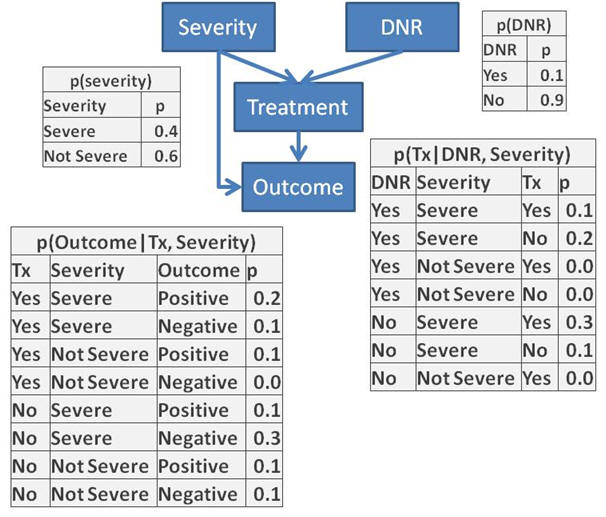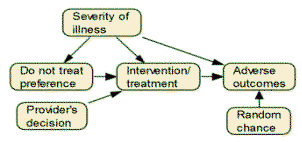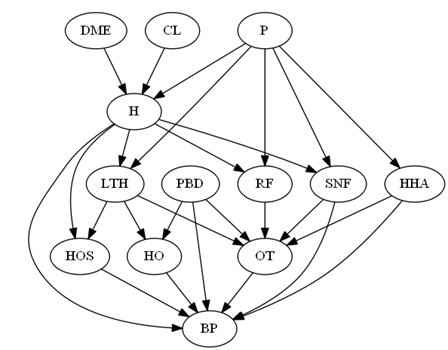|
Supplement to Chapter on Causal Neworks
Presentations
-
Introduction to causal inference Read
1► Read
2► Video► Slides►
-
Causal impact, d-separation and backdoors Slides►
-
Blocking backdoor Read► Slides►
-
Example of back door criterion Read►
-
Minimizing stratification through backdoor criterion Read► Slides►
-
Network analysis using Grow Shrink & Hiton & Sequence R
code► Slides► Soylu's
Video►
-
Network analysis using Poisson regression Read► Dispersion►
-
Optimizing stratification Read►
-
Impact of sequence on accuracy of network learning algorithms Read►
Assignment
For this assignment you can use any statistical package, including R,
SAS, and SPSS. Your instructor is familiar with Netica and
BayesiaLab. R packages are also used often. OpenBUGS and
Gibbs Sampler, Stan, OpenMarkov, and Direct Graphical Model are open
source software. Netica is free for networks less than 15 nodes. A
more complete list is available in Wikipedia under "Bayesian Networks." OpenBUGS► Stan► Direct
Graphical Models► OpenMarkov► Graphical
Models Toolkit► PyMC► Genie
Smile► SamIam► Bayes
Server► AIspace► BayesiaLab► Hugin► AgenaRisk► dVelox► System
Modeler► UnBBayes► Uninet► Tetrad► Dezide► Netica►
Work on this assignment can be done in group's of two students but you
cannot work with a student that you have previously teamed up with.
Question 1: Draw networks based on the following
independence assumptions. When directed networks are possible, give
formulas for predicting the last variable in the networks from marginal
and pair-wise conditional probabilities. Keep in mind that absence of
independence assumption implies dependence. Review►
|
Nodes in Network |
Assumption |
|
X, Y, Z |
I(X,Y) |
|
X, Y, Z |
I(X,Y), Not I(X,Y|Z) |
|
X, Y, Z |
I(X,Y), I(X,Y|Z), Y measured last |
|
X, Y, Z, W |
I(X,Y), I(X,Y|Z), I({X,Y},W|Y), W measured last |
|
X, Y, Z, W |
I(X,Y), I(Z,W), and measured in the order given |
Redo this assignment assuming that W, X, Y, Z occur in order, meaning W
before X, X before Y, and Y before Z. How have your networks changed?
Wang's Video►
Question 2: Construct a Bayesian probability network
model that would predict success with citalopram. A network model will
include variables, and mediators of the effect of variables, on response
to citalopram. Include at least 5 variables in your model. Remission
or relapse should be considered an end node. Variables that cannot be
altered (e.g. year of birth or family history) should be considered root
nodes. All other variables, e.g. diagnoses, could be either root or
intermediary nodes. The structure of the network model could be based on
expert's opinion, analysis of conditional independence, and your own
analysis of association among the variables. The probabilities among
the variables should be estimated from the data. Bushra's
Response► Shruti's
Video►
Aras's Video►
Question 3: Write an SQL code to calculate the
probability of negative outcome in the situation where the patient is
severely ill and has not signed a "Do Not Resuscitate" (DNR) order.
Note that probabilities for events that are mutually exclusive and
exhaustive should add up to one. Data► Bushra's
Response►Anto's Video► Slides► SQL►

Question 4: Redo problem 3 in Netica or other
software and verify the accuracy of your answer. To accomplish this
project organize the 4 node network inside Netica and direct the links
between the nodes as in the graph structure. Then for every node, enter
the table of probabilities as per tables given in Question 3. For
example, for the DNR node enter the two probabilities of 0.1 and 0.9
into the Table within the node for DNR. Once the entire network (the
graph and the related probabilities) has been entered into Netica,
evaluate the risks for
a patient who is severely ill and has not signed a "Do Not Resuscitate"
order. Netica► Shruti's
Video►
Question 5: Inside
an electronic health record, there are data on outcomes of a particular
intervention. Using the network drawn below, write the equations
that would allow you to estimate what would happen if the intervention
was not given. First, write an equation for each node in the
network based on variables that precede it. For example, the
regression equation for predicting whether there is an adverse event is
given by the equation:
Outcome = a + b Treatment + c Severity
Second, set the variables that change across these equations to the
relevant values. For example, set Treatment to be zero.

Question 6: The
following graph was used to simulate data on bundling payment for total
hip fracture treatment:

- Recover the original network and calculate the causal impact of H on BP.
Data►
R Code►
Detailed R Code►
-
If you were using logistic or ordinary regression equations, write
what set of equations are represented by the above network. In
each instance write all the variables that are in the regression
equation and the variables that have a statistically significant
relationship with the response variable. For example, LTH is
regressed on all variables that precede it which are DME, CL, P and
H. But only P and H have a statistically significant
relationship with LTH. This regression can be shown as:
LTH = a + b DME + c CL + d P* + e H*
In the above equation, the statistically significant relationships
are shown with a star (*). A missing star indicates an
insignificant relation. Using the data, estimates the
parameters of each of the regressions. Can these set of
equations be used to create the network. In how many ways does
the regression equations differ from the network model in the
graph.
Question 7: Construct
a decision aid for selection among antidepressants.
-
Read about the STAR*D study protocol. Review►
-
Download data. Use instructor's last name as password. Data►
-
Repeat the following analysis for at least 5
antidepressant(s). Separate analysis must be done for each
antidepressant or antidepressant combination (shown in variable
CONCAT).
-
Create data sets for each antidepressant(s) combination. This
data sets will include a patient several times, if the patient
received different combinations of antidepressants over
time. Group By Concat and ID variable to remove the weekly
data. If the patient received the antidepressant(s) combination,
assign it a value of 1 and otherwise, when they received other
combination of antidepressant(s) assign it a value of 0.
-
Identify the parents in the Markov Blanket of each
antidepressant. You can use logistic regression to do this.
For each antidepressant use all variables that precede it as
independent variables in the regression. Use the variables that
are significant predictors of the antidepressant as the parents
in the Markov Blanket of the antidepressant.
-
Stratify treatment and exclude from the list of parents in the
Markov Blanket any variable not related to remission (measured
as referred to follow-up). Calculate the unconfounded impact of
antidepressant(s) on remission. Stratify the remaining
variables in the parents in the Markov Blanket of treatment and
calculate the impact of antidepressant(s) on remission.
-
Evaluate for a patient with PTSD and neurological disorders which of
the 5 antidepressant(s) combination is most likely to lead to
remission.
More
For additional information (not part of the required reading), please
see the following links:
-
Meta analysis through Bayesian networks Read►
-
Introduction to Bayesian networks Read►
-
Learning Bayesian Networks
Read►
-
Selection of Judea Pearl's articles PubMed►
-
Applications of Bayesian networks in healthcare PubMed►
- Use
of graphs in removing confounding Read►
-
Learning Bayesian networks from correlated data Read►
-
Bayesian networks in neuroscience Read►
-
Cost analysis using Bayesian networks Read►
-
Comparison of Bayesian network and logistic models Read►
-
Bayesian network classifiers Read►
-
Introduction to Markov process Tim's
Lecture►
-
Explanation of predictions Aloudah's
Lecture►
-
Outcome based prescribing for citalopram Slides►
|
![]()